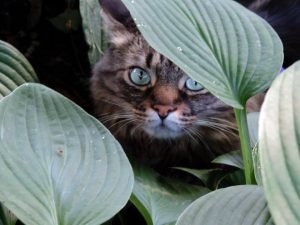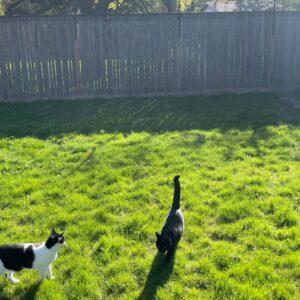Celebrating Cats: Then and Me-ow
 This blog is written by Nature Canada guest blogger Tina-Louise Rossit.
This blog is written by Nature Canada guest blogger Tina-Louise Rossit.
It’s International Cat Day! For those that didn’t know, is it not a purrfect reason to celebrate? All meows aside, dogs may be man’s best friend, but cats definitely rule! Read on to find out a little history about our feline friends then, and what’s up with cats now.
PART 1 – THEN
Cats have been around for a long time. The first signs of domestication have recently been found to date all the way back 12, 000 years ago! This is about the time when agriculture was developing in the Fertile Crescent of the Middle East. When new agriculture methods introduced the idea of surplus crops, it came with a cost; rodents. Luckily for humans, rodents attracted wildcats as well. The cats saw the opportunity of a free buffet and seized their chance. Farmers were happy to encouraged this cost-free pest control and voilà, the beginning a positive relationship between cat and human.
Among the course of history, the cat has had a strong cultural influence on many civilizations. The most common relationship is that of the Ancient Egyptians and their devotion to cats as an entity. The goddess Bastet, who is represented by a woman with the head of a black cat, is one of the most common known deities of ancient Egypt. She is the goddess of cats, protector of land and the home, guardian against evil, and a warrior.
The Romans and Greeks, on the other hand, valued the cat’s duty of catching vermin but did not consider owning a cat, rather allowing cats to roam freely as their guardians. In India and Persia, the cat was magical and mystical. Important feline figures can be found in Indian literature and folklore. All the way in China, cats were part of creation stories as the keepers of time and order. The Japanese also have a high respect for the cat, hence the “Beckoning Cat” statue, commonly known today as a talisman of good fortune and honour.

Susanne Swayze
The negative attitude towards cats came with the Medieval times when the Christian Church began to demonize pagan symbols, icons, and rituals. Poor cats, especially black cats, were thought to be the devil on four legs, and such to kill a cat, was to purge the evil within. Some scholars argue that the decrease in cats increased the rodent population, and thereby increased the fleas carrying the Bubonic Plague bacteria. Finally, the Victorian Era restored the compassion towards cats. Queen Victoria had an interest in reading about ancient civilisations, such as the Ancient Egyptians, and began to honour the attitude of grace and guardianship towards the cat. She begun to own cats in her court for which became publicly known – and thanks to her popularity as a royal figure, people followed her trend.
“Over the pond”, as they say, cats in North America followed a similar historical pattern. They were brought aboard the ships by colonists to bring to the new worlds as pest control. The Americas also had a dark age, and cats did not have a good time during the Salem Witch Trials. Luckily decades afterwards, cats began earning some of the appreciation they deserve, as feline characters begun popping up in all types of literature.
Now let’s not forget Canadian cats! Did you know that in 1924, cats were brought to Parliament as pest control? The Parliamentary Cats as they were known as, were “employed” up until 1955 before pesticides were invented and widely used. The cats were freed but stayed in the general area becoming a cat sanctuary. Volunteers cared and maintained the sanctuary up until its closing in 2013, when finally, the remaining cats were adopted into loving homes.
PART 2 – MEOW
That was then, what about now? Cats today are a favourite pet choice. Although, if there’s one thing hasn’t changed, it is the way we still think of cats as being a little bit on the wild side. We still let our cats outdoors to roam around, we don’t take our cats on walks, nor to cat parks, nor on family outings – can you see the problem here?
In 2017, Humane Canada released a 5-year update about the national cat overpopulation crisis. We may love our cats but we don’t treat them as well as we do our dogs. Many owners let them roam outdoors, exposing them to risk from cars, diseases, wildlife, pests, poisons and parasites. How come? Animal shelters receive twice as many cats as dogs, despite the populations being of similar size. There are countless stray cats and tens of thousands are homeless . A lot of people still don’t spay or neuter their pets, and let them roam outdoors despite the dangers to the cats. As a result, cat overpopulation is a serious issue.

Photo by Kitrina Russell.
Outdoor cats also pose a threat to birds and wildlife. Environment Canada conducted a study estimating that millions of birds per year that are preyed upon by domestic cats, both feral and pets. For soaring birds and birds that remain high up in the trees, cats aren’t much of a problem. But for the 115 or so bird species in Canada that nest or feed on the ground, they are definitely an issue. Sure, birds might be annoying at 4 am chirping as they welcome the sunrise, but no one wants to say bye to birds forever. Alright then, what can we do?
In February 2016, Nature Canada launched an initiative called Keep Cats Safe and Save Birds Lives. Cats and Birds is a coalition of national, regional, and local partners working to raise awareness and educate citizens about cat welfare, bird welfare, and cat and bird welfare together. Already two years strong, it’s time for a little more recognition. This International Cat Day, go check out their website and take action! You’ll find out a bunch of interesting stuff such as healthy alternatives to letting your cat roam outdoors. You can train your cat to wear a harness and take them on adventure walks.
If we give healthy and happy enrichment to our dogs with toys and dog houses and dog parks and love, the same thing can and should exist for our cats! Have you heard of “catios”? Because let me tell you, they’re pretty great! Changing the way we treat our kitties will not only change our outlook for pets in general, but we’re also helping bird species not get eaten and well, not go extinct.
Together we can end this cat-astrophe and move fur-ward. We just need to stay paw-sitive and climb that meow-tain of changes!
Written by Nature Canada guest-blogger, Tina-Louise Rossit.

|
Want more nature news?Discover more about the nature you love. |
Sources
A Brief History of House Cats
Domestic Cats DNA – Genetics
Cats Interaction with Humans
Cats in the Ancient World
Canadian Parliamentary Cats



